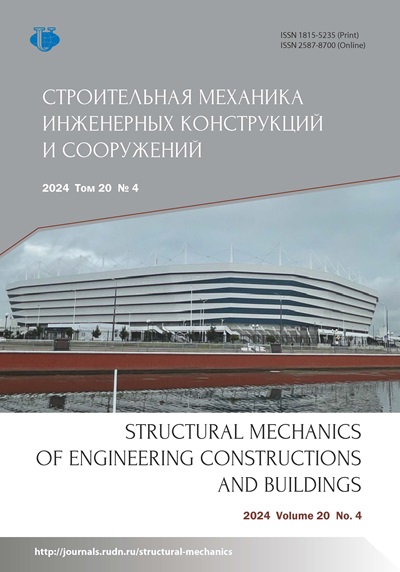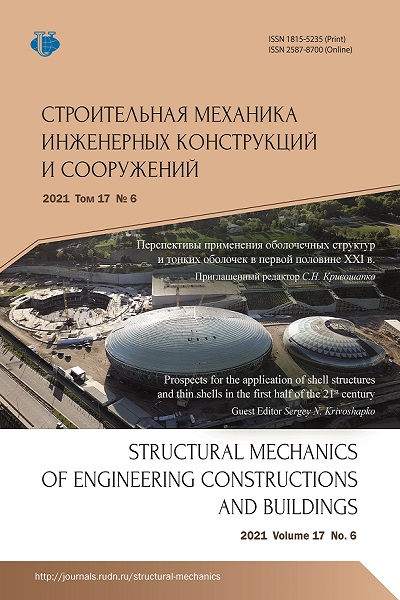Геометрия нормальных линейчатых поверхностей
- Авторы: Иванов В.Н.1
-
Учреждения:
- Российский университет дружбы народов
- Выпуск: Том 17, № 6 (2021): Перспективы применения оболочечных структур и тонких оболочек в первой половине XXI в.
- Страницы: 562-575
- Раздел: Формообразование оболочек
- URL: https://journals.rudn.ru/structural-mechanics/article/view/30913
- DOI: https://doi.org/10.22363/1815-5235-2021-17-6-562-575
Цитировать
Полный текст
Аннотация
Рассматривается формирование широкого круга поверхностей на основе нормальных линейчатых поверхностей, образуемых движением прямой линии в нормальной плоскости базовой направляющей кривой. Образующая прямая может вращаться по заданному закону в нормальной плоскости базовой кривой. Приводится векторное уравнение поверхностей, с произвольной пространственной и плоской направляющей кривой. Получены формулы геометрических характеристик поверхности. На основе полученных формул показано, что координатная система нормальной линейчатой поверхности является ортогональной, но в общем случае не сопряженной. Прямые линии не являются линиями главных кривизн поверхности и нормальные линейчатые поверхности в общем случае не являются торсовыми, развертывающимися поверхностями. Получено условие вращения образующей прямой в нормальной плоскости базовой кривой, при выполнении которого координатная сеть будет сопряженной - нормальная линейчатая поверхность развертывающейся. Для пространственной базовой кривой это условие связано с кривизной базовой кривой, для плоской кривой образующая прямая движется в нормальной плоскости направляющей плоской кривой с постоянным наклоном к плоскости базовой плоской кривой - поверхность одинакового ската. На основе векторного уравнения построены рисунки нормальных линейчатых поверхностей с использованием программного комплекса MathCAD.
Об авторах
Вячеслав Николаевич Иванов
Российский университет дружбы народов
Автор, ответственный за переписку.
Email: i.v.ivn@mail.ru
ORCID iD: 0000-0003-4023-156X
доктор технических наук, профессор департамента строительства, Инженерная академии
Российская Федерация, 117198, Москва, ул. Миклухо-Маклая, д. 6Список литературы
- Монж Г. Приложение анализа к геометрии. М.: ОНТИ, 1936.
- Dupin Ch. Application de Geometrie et de Mechanique. Paris: Bachelier, 1822.
- Шуликовский В.И. Классическая дифференциальная геометрия. М.: ГИФМЛ, 1963. 540 с.
- Рашевский П.К. Курс дифференциальной геометрии М. – Л.: ГИТТЛ, 2004. 428 с.
- Каган В.Ф. Основы теории поверхностей. М. – Л.: ОГИЗ, 1947. 407 с.
- Hilbert D., Cohn-Vossen S. Geometry and the imagination. 2nd ed. Chelsea, 1952.
- Гильберт Д., Кон-Фоссен С. Наглядная геометрия. М.: Наука, 1981. 344 с.
- Санчес-Аркас. Оболочки. М.: Изд-во литературы по строительству, 1961. 172 с.
- Рекач В.Г., Кривошапко С.Н. Расчет оболочек сложной геометрии. М.: Изд-во УДН, 1988. 176 с.
- Кривошапко С.Н. Торсовые поверхности и оболочки: справочник. М.: Изд-во УДН, 1991. 287 с.
- Кривошапко С.Н. Геометрия линейчатых поверхностей с ребром возврата и линейная теория расчета торсовых оболочек. М.: РУДН, 2009. 357 с.
- Krivoshapko S.N., Ivanov V.N. Encyclopedia of analytical surfaces. Switzerland: Springer International Publishing, 2015. 752 p.
- Иванов В.Н., Кривошапко С.Н. Аналитические методы расчета оболочек неканонической формы. М.: РУДН, 2010. 540 с.
- Кривошапко С.Н., Алборова Л.А. Формообразование оболочек в архитектуре: М.: РУДН, 2008. 48 с.
- Кривошапко С.Н., Мамиева И.А. Аналитические поверхности в архитектуре зданий, конструкций и изделий. М.: ЛИБРОКОМ, 2012. 328 с.
- Иванов В.Н., Романова В.А. Конструкционные формы пространственных конструкций. Визуализация поверхностей в системах MathCad и AUTOCad. М.: Изд-во АСВ, 2016. 412 с.
- Кривошапко С.Н. аналитические линейчатые поверхности и их полная классификация // Строительная механика инженерных конструкций и сооружений. 2020. Т. 16. № 2. С. 131–138. https://doi.org/10.22363/1815-5235-2020-16-2-131-138
- Зенкевич О. Метод конечных элементов. М.: Мир, 1975. 344 с.
- Агапов В.П. Метод конечных элементов в статике, динамике и устойчивости конструкций. М.: Изд-во АСВ, 2004. 248 с.
- Иванов В.Н., Наср Ю.А. Расчет оболочек сложной геометрии вариационно-разностным методом // Строительная механика инженерных конструкций и сооружений: межвузовский сборник научных трудов. Вып. 9. М.: АСВ, 2000. С. 25–34.
- Иванов В.Н. Вариационные принципы и методы решения задач теории упругости. М.: РУДН, 2001. 176 с.
- Иванов В.Н. Геометрия и формообразование нормальных поверхностей с семейством плоских координатных линий // Строительная механика инженерных конструкций и сооружений. 2011. № 4. С. 6–14.
- Иванов В.Н., Имомназаров Т.С., Фархан И.Т. Ортогональная криволинейная система координат и построение поверхностей на трапециевидно-криволинейных планах // Вестник Российского университета дружбы народов. Серия: Инженерные исследования. 2017. T. 18. № 4. С. 518–527.
- Vtlimirovic L.S., Stancovic M.S., Rradivojevic G. Modeling conoid surfaces // Facta Universitatis: Architicture and Civil Engineering. 2002. Vol. 2. No. 4. Pp. 261–266.
- Кривошапко С.Н., Басов Ю.К., Якушина А.А. Исследования по расчету и применению коноидальных оболочек // Строительная механика инженерных конструкций и сооружений. 2001. Вып. 10. С. 7–14.
















